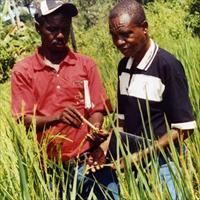GAMBIA: Can farmers axe rice imports through ‘Nerica’?

Heavy dependence on imported rice is crippling Gambian consumers, leading the government to call for New Rice for Africa, or Nerica, production to double.
Nerica, a cross between low-yield African rice and high-yield Asian rice varieties, matures quickly, is more pest-resistant than many varieties, does not require intensive irrigation or fertilisers, and is high in protein.
The African Rice Initiative (WARDA) and its partners, in search of a high-yield rice variety suitable to Sub-Saharan Africa, developed Nerica in 1996.
The Gambia imports up to 175,000 tonnes of rice annually, or approximately 70 percent of its rice needs, according to Moustapha Ceesay, adviser at the government’s National Agriculture Research Institute (NARI).
The price of imported rice has quadrupled since 2002, reaching a high of US$1 per kilogram earlier this year.
Nerica production has concurrently grown in recent years – doubling since 2006, and Ceesay estimates it will double again in 2009.
“There is no doubt that Nerica could help The Gambia become self-sufficient [in rice],” said Inoussa Akintayo, regional coordinator for WARDA, which helped introduce Nerica to The Gambia.
Nerica can yield on average 3.5 to four tonnes of rice per hectare, as opposed to average yields of 1.5 to 2.5 tonnes for other rice varieties, according to Ceesay.
NARI says traditional African rice varieties produce approximately 100 grains for each cluster or ‘pinacle’ of rice, versus an average of 400 with Nerica.
“Nerica is the hope for food security for The Gambia,” NARI’s Ceesay said. “It can be cultivated anywhere, without the need for irrigation, so you can increase the area of rice that is grown without high capital investment.”
Consumption of rice in Africa is growing more rapidly than for any crop and, according to WARDA, creating a need to boost production across the continent.
Government enthusiastic
Gambian President Yahya Jammeh has set up an initiative to encourage farmers to buy and grow Nerica.
In 2007 he launched a campaign urging Gambians to “go back to the land” and aim for self-sufficiency in food production. Nerica, President Jammeh has said, is a part of the solution. The president is growing 40 hectares of Nerica on his farm in Kanilai, 68km from the capital Banjul.
Some 5,000 farmers are now using Nerica, according to Moussa Mawnneh, president of the country’s biggest farmers association with 455,000 members. Most of the rice-growers among them are women, who lead in rice production in The Gambia.
Impact on farmers
Many of the farmers have joined rice growers associations through which they help each other store and sell surplus seeds and, if they can afford it, rent equipment.
Members of the Yirima Kafo rice-growing cooperative in Jambur, a village 30km east of Banjul, say the comparatively high Nerica yields mean they are able to sell their surplus at US$1.20 per kg, and they have used the profits to open a bank account, and set up a microcredit loan system.
Rice-grower Juju Gassama told IRIN “There is a vast difference between Nerica and the other rice variety, ‘Kokuru’ that we grow. As a result 85 percent of us [farmers in her association] have shifted to Nerica.”
“I am better able to feed my family with Nerica – it has changed my life as a woman.”
“Too simplistic”
But according to WARDA spokesperson Savitri Mohapatra, it is “far too simplistic” to think Nerica can make The Gambia food self-sufficient.
“Farmers need inputs such as seed, fertiliser and tools to intensify their production. Gaps between actual farmer yields and what is possible are huge, and these cannot be closed by the [rice] variety alone.”
Most members of the Yirima Kafo rice-growers association do not have access to animals so they prepare the land by hand. They have no thresher and they must walk several kilometres to the market to mill their rice, according to WARDA.
NARI’s Ceesay said he recognises a higher percentage of government funds should have been set aside to invest in equipment and market development. “Just giving seeds isn’t enough,” he said.
The Gambian government does not subsidise fertilisers as do the governments of Togo, Liberia, Benin and Mali, farmers association president Mawnneh said.
He said without fertiliser people will look to more land to increase their harvests. “If the government does not provide fertilisers, farmers will have to start encroaching on forest areas to grow Nerica.”
Seed demand outstrips supply
But boosting Nerica production is stymied by a shortage of seeds, with “demand now outstripping supply,” said NARI’s Ceesay.
Farmers must learn how to produce and store seeds with help from investors, according to Mawnneh. “We need to start up seed banks, and revolving seed funds. There are no big seed banks here now – farmers just swap seeds between themselves,” he told IRIN.
Funders such as the African Development Bank (ADB) and Food and Agriculture Organization are stepping in to help. The ADB has created a US$35-million pool to boost Nerica production across seven countries. WARDA is using ADB funds to train farmers how to produce and manage seeds through a community-based system.
But private investors must step in to help create the conditions for a dynamic seed market, said WARDA’s Akintayo. “We need to encourage them [to invest] by telling them the seed market is going to grow year-on-year for the next 10 years.”
Currently just 37 percent of The Gambia’s arable land is exploited, leaving 20 million hectares of rain-fed lowland available for Nerica cultivation, WARDA estimates.
“According to the trends we’re seeing if it continues like this, who knows, Gambian farmers could even become rice exporters,” Akintayo said.
 Back and Next - Back and Next
Back and Next - Back and Next See Also - See Also
See Also - See Also